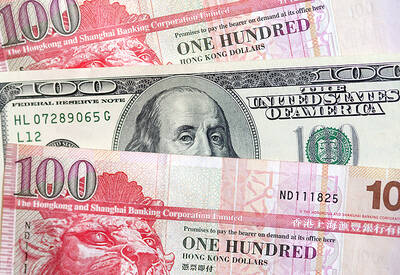The central bank has completed a wholesale feasibility and technology study of a central bank digital currency (CBDC) and is gathering feedback and refining a platform design, Deputy Governor Chu Mei-lie (朱美麗) said yesterday.
Chu shared her views on the evolution and future of CBDCs in a keynote speech at an annual event organized by Financial Information Service Co (財金資訊), which oversees Taiwan’s banking, payment and settlement systems.
CBDCs are similar to cryptocurrencies, except that their value is fixed by a government authority and they are equivalent to a national currency.

Photo courtesy of the central bank
Chu said she agreed with the Bank for International Settlements that existing payment tools and platforms would not always be able to meet needs from all-day transactions, smart contracts and automatic settlements that allow simultaneous and irreversible transfers of assets or funds.
A nation’s monetary system should support tokenized assets and CBDCs might provide ultimate payment and settlement services, including tokenization and a unified ledger to integrate CBDC and traditional currencies, she said.
Unified legers would integrate CBDCs with tokenized real-world assets in the same programmable platform, with the CBDC the core ledger and the ultimate settlement of assets, she said.
The concept of a unified ledger does not mean there is only one ledger, but the tokenized ledger of each economy can coexist and be connected through an application interface to ensure interoperability and therefore reduce the risk of errors in message transmission, she said.
It is also intended to speed up the clearing process, create a safe trading environment and ensure that currency and asset transactions are carried out in a safe, reliable and effective manner, Chu said.
Foreign central banks are exploring and evaluating the feasibility of issuing CBDCs to make sure that all forms of currency have a single value, she said.
Taiwan’s central bank is prudently approaching the issue and has no timetable on when to reach a conclusion, she said.
The monetary policymaker would hold discussions with academics and business sectors while considering its stance, Chu said.
In the meantime, the central bank would seek to improve the overall planning regarding the platform design, transaction ease and capacity, as well as innovative functions, she said.
In addition, it is taking into consideration offline transaction scenarios, she added.

The US dollar was trading at NT$29.7 at 10am today on the Taipei Foreign Exchange, as the New Taiwan dollar gained NT$1.364 from the previous close last week. The NT dollar continued to rise today, after surging 3.07 percent on Friday. After opening at NT$30.91, the NT dollar gained more than NT$1 in just 15 minutes, briefly passing the NT$30 mark. Before the US Department of the Treasury's semi-annual currency report came out, expectations that the NT dollar would keep rising were already building. The NT dollar on Friday closed at NT$31.064, up by NT$0.953 — a 3.07 percent single-day gain. Today,

‘SHORT TERM’: The local currency would likely remain strong in the near term, driven by anticipated US trade pressure, capital inflows and expectations of a US Fed rate cut The US dollar is expected to fall below NT$30 in the near term, as traders anticipate increased pressure from Washington for Taiwan to allow the New Taiwan dollar to appreciate, Cathay United Bank (國泰世華銀行) chief economist Lin Chi-chao (林啟超) said. Following a sharp drop in the greenback against the NT dollar on Friday, Lin told the Central News Agency that the local currency is likely to remain strong in the short term, driven in part by market psychology surrounding anticipated US policy pressure. On Friday, the US dollar fell NT$0.953, or 3.07 percent, closing at NT$31.064 — its lowest level since Jan.

Hong Kong authorities ramped up sales of the local dollar as the greenback’s slide threatened the foreign-exchange peg. The Hong Kong Monetary Authority (HKMA) sold a record HK$60.5 billion (US$7.8 billion) of the city’s currency, according to an alert sent on its Bloomberg page yesterday in Asia, after it tested the upper end of its trading band. That added to the HK$56.1 billion of sales versus the greenback since Friday. The rapid intervention signals efforts from the city’s authorities to limit the local currency’s moves within its HK$7.75 to HK$7.85 per US dollar trading band. Heavy sales of the local dollar by

The Financial Supervisory Commission (FSC) yesterday met with some of the nation’s largest insurance companies as a skyrocketing New Taiwan dollar piles pressure on their hundreds of billions of dollars in US bond investments. The commission has asked some life insurance firms, among the biggest Asian holders of US debt, to discuss how the rapidly strengthening NT dollar has impacted their operations, people familiar with the matter said. The meeting took place as the NT dollar jumped as much as 5 percent yesterday, its biggest intraday gain in more than three decades. The local currency surged as exporters rushed to